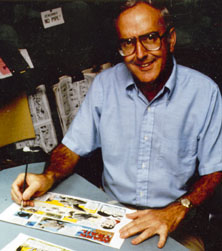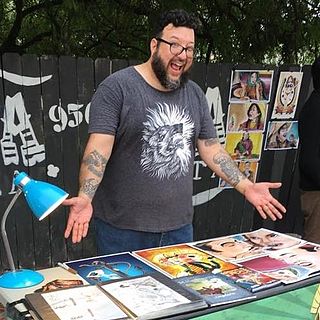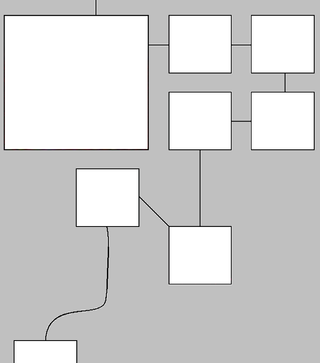Webcomics are comics published on a website or mobile app. While many are published exclusively on the web, others are also published in magazines, newspapers, or comic books.

A cartoonist is a visual artist who specializes in both drawing and writing cartoons or comics. Cartoonists differ from comics writers or comic book illustrators in that they produce both the literary and graphic components of the work as part of their practice. Cartoonists may work in a variety of formats, including booklets, comic strips, comic books, editorial cartoons, graphic novels, manuals, gag cartoons, storyboards, posters, shirts, books, advertisements, greeting cards, magazines, newspapers, webcomics, and video game packaging.
Serializer.net was a webcomic subscription service and artist collective published by Joey Manley and edited by Tom Hart and Eric Millikin that existed from 2002 to 2013. Designed to showcase artistic alternative webcomics using the unique nature of the medium, the works on Serializer.net were described by critics as "high art" and "avant-garde". The project became mostly inactive in 2007 and closed alongside Manley's other websites in 2013.

Keenspot is a webcomics portal founded in March 2000 by cartoonist Chris Crosby, Crosby's mother Teri, cartoonist Darren Bleuel, and Nathan Stone.

Cayetano 'Cat' Garza is a comic artist, cartoonist, illustrator, and musician in the United States. He is best known for his experiments with webcomics.

Derek Kirk Kim is a Korean-American writer, director, and artist. He is the recipient of the Eisner (2004), the Harvey (2004), and the Ignatz Award (2003) for his debut graphic novel Same Difference and Other Stories.. This collection of short stories was first published with the help of a 2002 Xeric Award.

Patrick Sean Farley is a freelance illustrator and Web page designer. Known as a pioneer of webcomics as a medium, Farley works out of Oakland, California.

Manhua are Chinese-language comics produced in China and Taiwan. Whilst Chinese comics and narrated illustrations have existed in China in some shape or form throughout its imperial history, the term manhua first appeared in 1904 in a comic titled Current Affairs Comics in the Shanghai-based newspaper Jingzhong Daily.

The infinite canvas is the feeling of available space for a webcomic on the World Wide Web relative to paper. The term was introduced by Scott McCloud in his 2000 book Reinventing Comics, which supposes a web page can grow as large as needed. This infinite canvas gives infinite storytelling features and creators more freedom in how they present their artwork.
Neil Kleid is an American cartoonist who received a 2003 Xeric Award grant for his graphic novella Ninety Candles (2004). Raised in Oak Park, Michigan, he lives in New Jersey
Daniel Merlin Goodbrey is an English writer known for his work in webcomics and the British small press.

Eric Millikin is an American artist and activist based in Detroit, Michigan. He is known for his pioneering work in artificial intelligence art, augmented and virtual reality art, conceptual art, Internet art, performance art, poetry, post-Internet art, video art, and webcomics. His work is often controversial, with political, romantic, occult, horror and black comedy themes. Awards for Millikin's artwork include the Pulitzer Prize.
The history of comics has followed different paths in different parts of the world. It can be traced back to early precursors such as Trajan's Column, in Rome, Egyptian hieroglyphs and the Bayeux Tapestry.
Ethan Persoff is an American cartoonist, archivist, and sound artist. His work as an archivist includes a complete digitization of Paul Krassner's counterculture magazine The Realist, and the website Comics with Problems, which has been featured on multiple segments of The Rachel Maddow Show. As a comics artist, he has been published by Fantagraphics, and received media attention for his website projects, including two projects with artist and co-collaborator Scott Marshall; a downloadable Halloween mask based on Senator Larry Craig and a Tijuana Bible based on George W. Bush and John McCain. His late granduncle was Nehemiah Persoff.

Gisèle Lagacé is a Canadian comics writer and artist, writer and illustrator of webcomics. She is best known for her series Ménage à 3.
The history of webcomics follows the advances of technology, art, and business of comics on the Internet. The first comics were shared through the Internet in the mid-1980s. Some early webcomics were derivatives from print comics, but when the World Wide Web became widely popular in the mid-1990s, more people started creating comics exclusively for this medium. By the year 2000, various webcomic creators were financially successful and webcomics became more artistically recognized.
Drew Weing is an American comic artist. Debuting in 2010 with the black-and-white graphic novel Set to Sea, Weing went on to create the webcomic The Creepy Case Files of Margo Maloo. Together with his wife Eleanor Davis, Weing has taught cartooning classes at the University of Georgia. Weing is large fan of the serialized aspect of webcomics.

The Right Number is an infinite canvas webcomic by Scott McCloud. The webcomic makes use of an experimental zooming user interface, where each subsequent panel is nested inside of the panel that comes before it. The Right Number follows a man who discovers that one can figure out someone's character traits based on their phone number, and starts to abuse the patterns he finds to search the perfect girlfriend. The story is focused on obsession and how it is impossible to find the perfect mate. Two of its three parts were published in 2003 through the BitPass micropayment service McCloud was a consultant for at the time. The third part was never released, and when BitPass went under in 2007, McCloud released the two existing parts of The Right Number for free.

Webcomics in France are usually referred to as either blog BD or BD numérique. Early webcomics in the late 1990s and early 2000s primarily took on the form of personal blogs, where amateur artists told stories through their drawings. The medium rose in popularity in economic viability in the country in the late 2000s and early 2010s. The Turbomedia format, where a webcomic is presented more alike a slideshow, was popularized in France in the early 2010s.

The Morning Improv is a series of webcomics created by Scott McCloud from 2001 to 2004. The series was entirely improvisational, as McCloud wrote one or two panels every morning. The title of each of the 26 webcomics McCloud created for The Morning Improv were selected by his readers.












